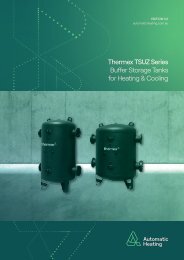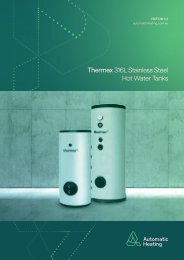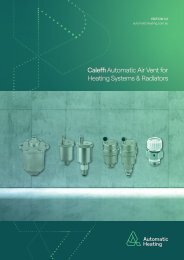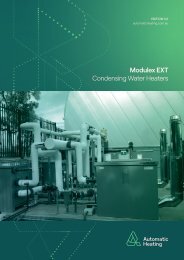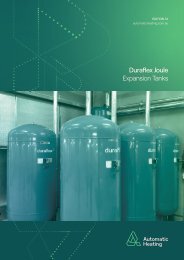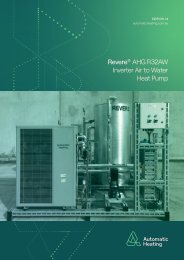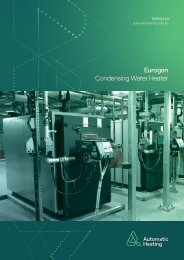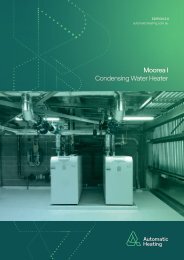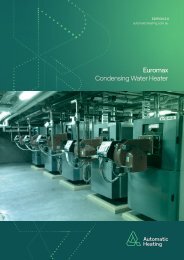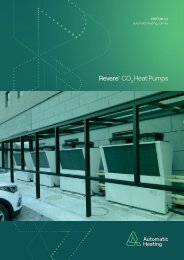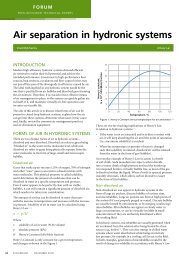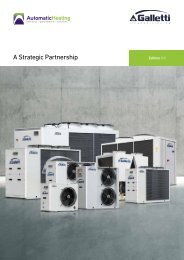- Page 1:
Solutions Guide Edition 2.7
- Page 4 and 5:
Company Overview Contents Company O
- Page 6 and 7:
The Automatic Heating Advantage Con
- Page 8 and 9:
Sales & Technical Support Contents
- Page 10 and 11:
Service & Maintenance Contents Serv
- Page 12 and 13:
HEAT PUMPS Heat Pumps Contents 10
- Page 14 and 15:
HEAT PUMPS Revere CO 2 - Air to Wat
- Page 16 and 17:
HEAT PUMPS Revere CO 2 - Air to Wat
- Page 18 and 19:
HEAT PUMPS Revere CO 2 - Air to Wat
- Page 20 and 21: HEAT PUMPS Revere CO 2 - Air to Wat
- Page 22 and 23: HEAT PUMPS Revere CO 2 - Air to Wat
- Page 24 and 25: HEAT PUMPS Revere R32 Inverter - Ai
- Page 26 and 27: HEAT PUMPS Revere R410A Inverter -
- Page 28 and 29: HEAT PUMPS Revere R410A - Air to Wa
- Page 30 and 31: HEAT PUMPS Revere R410A - Air to Wa
- Page 32 and 33: HEAT PUMPS Galleti MPI DC - Air to
- Page 34 and 35: HEAT PUMPS Galleti MPI DC - Air to
- Page 36 and 37: HEAT PUMPS Galleti MPE - Air to Wat
- Page 38 and 39: HEAT PUMPS Galleti MPE - Air to Wat
- Page 40 and 41: HEAT PUMPS Galleti MPE - Air to Wat
- Page 42 and 43: HEAT PUMPS Galleti MPE - Air to Wat
- Page 44 and 45: HEAT PUMPS Galleti HPS - Air to Wat
- Page 46 and 47: HEAT PUMPS Galleti HPS - Air to Wat
- Page 48 and 49: HEAT PUMPS Galleti EvitecH - Air to
- Page 50 and 51: HEAT PUMPS Galleti EvitecH - Air to
- Page 52 and 53: HEAT PUMPS Galleti EvitecH - Air to
- Page 54 and 55: HEAT PUMPS Galleti SCX - Air to Wat
- Page 56 and 57: HEAT PUMPS Galleti SCX - Air to Wat
- Page 58 and 59: HEAT PUMPS Galleti SCX - Air to Wat
- Page 60 and 61: HEAT PUMPS Contents 58
- Page 62 and 63: HEAT PUMPS Revere CO 2 - Water to W
- Page 64 and 65: HEAT PUMPS Revere R134A - Water to
- Page 66 and 67: HEAT PUMPS Heat Pump Application Ex
- Page 68 and 69: Condensing & Conventional Boilers C
- Page 72 and 73: Eurogen - Condensing Boilers Conten
- Page 74 and 75: Eurogen - Condensing Boilers Euroge
- Page 76 and 77: Eurogen - Condensing Boilers Euroge
- Page 78 and 79: Euromax - Condensing Boilers Conten
- Page 80 and 81: Euromax - Condensing Boilers Conten
- Page 82 and 83: Meridian - Condensing Boilers Conte
- Page 84 and 85: Meridian - Condensing Boilers Conte
- Page 86 and 87: Meridian - Condensing Boilers Conte
- Page 88 and 89: Meridian - Condensing Boilers Conte
- Page 90 and 91: Meridian - Condensing Boilers Conte
- Page 92 and 93: Meridian - Condensing Boilers Conte
- Page 94 and 95: Modulex EXT - Condensing Boilers Co
- Page 96 and 97: Modulex EXT - Condensing Boilers Co
- Page 98 and 99: Modulex EXT - Condensing Boilers Co
- Page 100 and 101: Modulex EXT - Condensing Boilers Co
- Page 102 and 103: Menu Menu Modulex EXT - Condensing
- Page 104 and 105: Modulex EXT - Condensing Boilers Co
- Page 106 and 107: Moorea I - Condensing Boilers Conte
- Page 108 and 109: Moorea I - Condensing Boilers Conte
- Page 110 and 111: Moorea I - Condensing Boilers Conte
- Page 112 and 113: Accessories - Condensing Boilers Co
- Page 114 and 115: Contents CONDENSING & CONVENTIONAL
- Page 116 and 117: Arizona - Conventional Boilers Cont
- Page 118 and 119: Arizona - Conventional Boilers Cont
- Page 120 and 121:
Arizona - Conventional Boilers Cont
- Page 122 and 123:
XRE - Conventional Boilers Contents
- Page 124 and 125:
XRE - Conventional Boilers Contents
- Page 126 and 127:
Enterprise Natural Gas Burners - Ga
- Page 128 and 129:
Enterprise Natural Gas Burners - Ga
- Page 130 and 131:
Enterprise Natural Gas Burners - Ga
- Page 132 and 133:
P K O P K Enterprise Natural Gas Bu
- Page 134 and 135:
L Z W AN J G Y P Enterprise Natural
- Page 136 and 137:
Enterprise Dual Fuel Burners - Gas,
- Page 138 and 139:
Contents CONDENSING & CONVENTIONAL
- Page 140 and 141:
Stainless Steel Flue System - Flue
- Page 142 and 143:
55 90 96 190 290 580 Stainless Stee
- Page 144 and 145:
Stainless Steel Flue Systems - Flue
- Page 146 and 147:
Stainless Steel Flue Systems - Flue
- Page 148 and 149:
Stainless Steel Flue Systems - Flue
- Page 150 and 151:
Flue Dilution - Flue Systems Conten
- Page 152 and 153:
Coaxial Flue System - Flue Systems
- Page 154 and 155:
Biomass Boilers Contents BIOMASS BO
- Page 156 and 157:
Wood Boilers Firex Wood Boilers - B
- Page 158 and 159:
Airex Wood Boilers - Biomass Boiler
- Page 160 and 161:
Fokolus Wood Boilers - Biomass Boil
- Page 162 and 163:
Pellet Boilers Pellexia Pellet Boil
- Page 164 and 165:
Accessories - Biomass Boilers Conte
- Page 166 and 167:
Expansion & Deaeration Contents EXP
- Page 168 and 169:
Expansion Tanks & Pressurisation Sy
- Page 170 and 171:
Expansion Tanks & Pressurisation Sy
- Page 172 and 173:
Duraflex Forté - Static Expansion
- Page 174 and 175:
Duraflex Joule - Static Expansion T
- Page 176 and 177:
Duraflex OEM & EN - Static Expansio
- Page 178 and 179:
Duraflex Ecopress Compact - Pressur
- Page 180 and 181:
Duraflex EcoPress - Pressurisation
- Page 182 and 183:
Duraflex EcoPress - Pressurisation
- Page 184 and 185:
Duraflex EcoPress - Pressurisation
- Page 186 and 187:
Duraflex EcoPress - Pressurisation
- Page 188 and 189:
Duraflex EcoPress Giga - Pressurisa
- Page 190 and 191:
Contents EXPANSION & DEAERATION 188
- Page 192 and 193:
Dirt and Air Separation Contents In
- Page 194 and 195:
Dirt and Air Separation Contents Co
- Page 196 and 197:
Air Separators - Dirt and Air Separ
- Page 198 and 199:
Air Separators - Dirt and Air Separ
- Page 200 and 201:
Dirt Separators - Dirt and Air Sepa
- Page 202 and 203:
Dirt Separators - Dirt and Air Sepa
- Page 204 and 205:
Dirt Separators - Dirt and Air Sepa
- Page 206 and 207:
Dirt and Air Separators - Dirt and
- Page 208 and 209:
Dirt and Air Separators - Dirt and
- Page 210 and 211:
Air Separators - Dirt and Air Separ
- Page 212 and 213:
Vacuum Deaerators - Dirt and Air Se
- Page 214 and 215:
Vacuum Deaerators - Dirt and Air Se
- Page 216 and 217:
Vacuum Deaerators - Dirt and Air Se
- Page 218 and 219:
Contents EXPANSION & DEAERATION 216
- Page 220 and 221:
Reduced Pressure Zone (RPZ) Devices
- Page 222 and 223:
Case Studies - Expansion & Deaerati
- Page 224 and 225:
Thermal Storage Contents THERMAL ST
- Page 226 and 227:
Hot Water Storage Tanks for Domesti
- Page 228 and 229:
Duplex 2205 Stainless Steel Hot Wat
- Page 230 and 231:
Duplex 2205 Stainless Steel Hot Wat
- Page 232 and 233:
Duplex 2205 Stainless Steel Hot Wat
- Page 234 and 235:
316L Stainless Steel Hot Water Tank
- Page 236 and 237:
316L Stainless Steel Hot Water Tank
- Page 238 and 239:
Duplex 2205 Stainless Steel Hot Wat
- Page 240 and 241:
Buffer Storage Tanks for Heating an
- Page 242 and 243:
Steel Buffer Storage Tanks - Therme
- Page 244 and 245:
Custom Buffer Tanks - Thermex® The
- Page 246 and 247:
Buffer Storage Tanks - Thermal Stor
- Page 248 and 249:
HVAC Pumps Contents HVAC PUMPS 246
- Page 250 and 251:
Saer Pumps Saer Pumps - HVAC Pumps
- Page 252 and 253:
Wilo Pumps Wilo Pumps - HVAC Pumps
- Page 254 and 255:
Grundfos Pumps Grundfos Pumps - HVA
- Page 256 and 257:
Grundfos Pumps - HVAC Pumps Content
- Page 258 and 259:
Inertia Bases Inertia Bases - HVAC
- Page 260 and 261:
Heat HVAC Exchangers Accessories- H
- Page 262 and 263:
Condensate Neutralisers Condensate
- Page 264 and 265:
Condensate Neutralisers - HVAC Acce
- Page 266 and 267:
Condensate Neutralisers - HVAC Acce
- Page 268 and 269:
Hydraulic Separators Hydraulic Sepa
- Page 270 and 271:
Heat Exchangers Heat Exchangers - H
- Page 272 and 273:
Valves and Gauges Valves and Gauges
- Page 274 and 275:
Valves and Gauges - HVAC Accessorie
- Page 276 and 277:
Valves and Gauges - HVAC Accessorie
- Page 278 and 279:
Valves and Gauges - HVAC Accessorie
- Page 280 and 281:
Water Treatment Products Water Trea
- Page 282 and 283:
Water Treatment Products - HVAC Acc
- Page 284 and 285:
Prefabrication Contents Prefabricat
- Page 286 and 287:
Prefabrication Contents Prefab Pack
- Page 288:
ABN 73 611 897 600 Automatic Heatin



